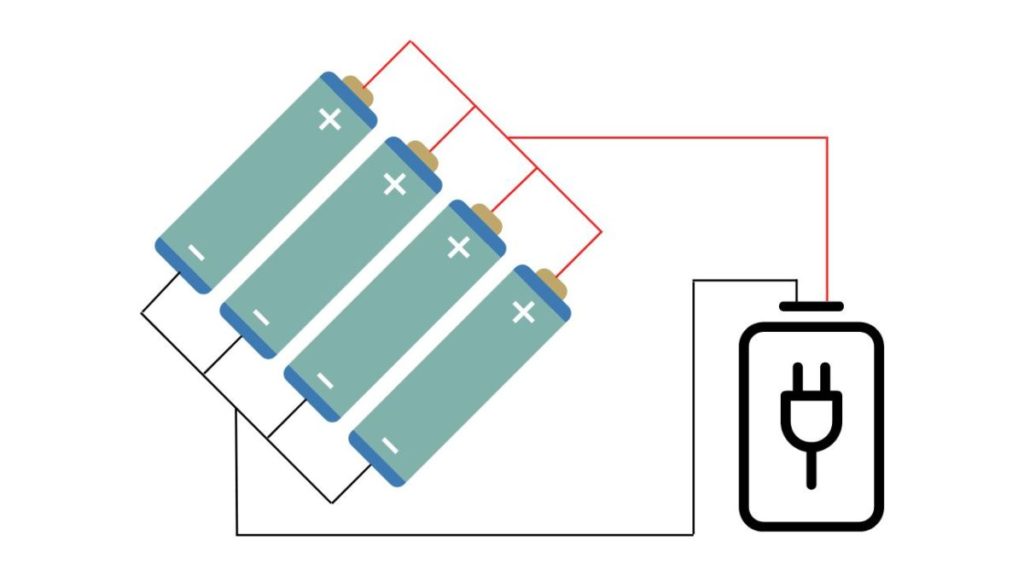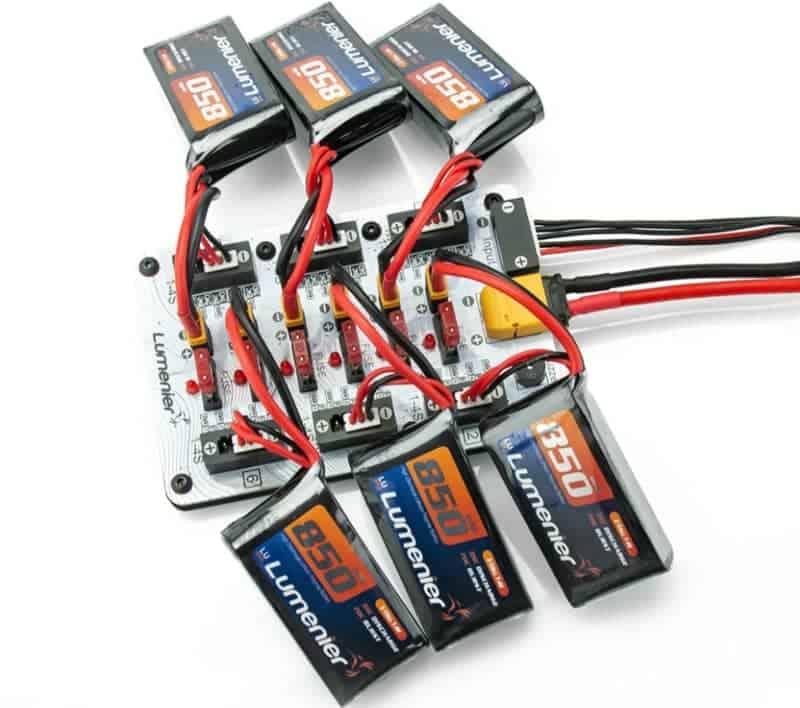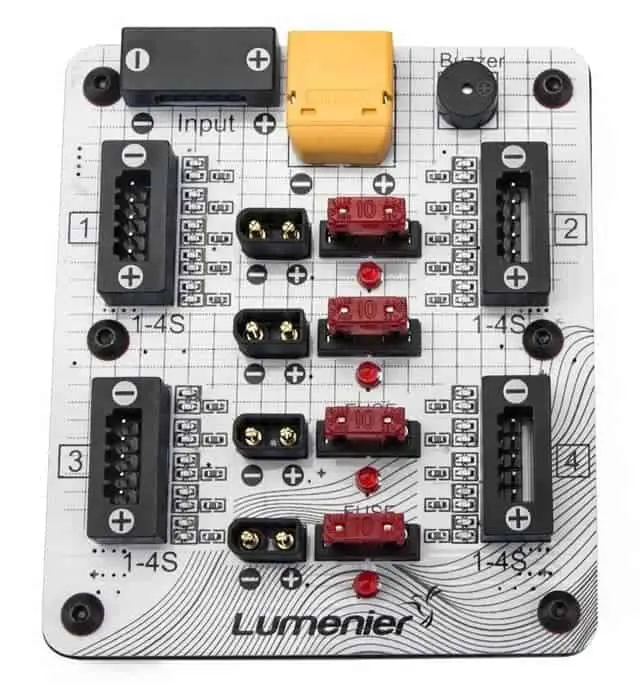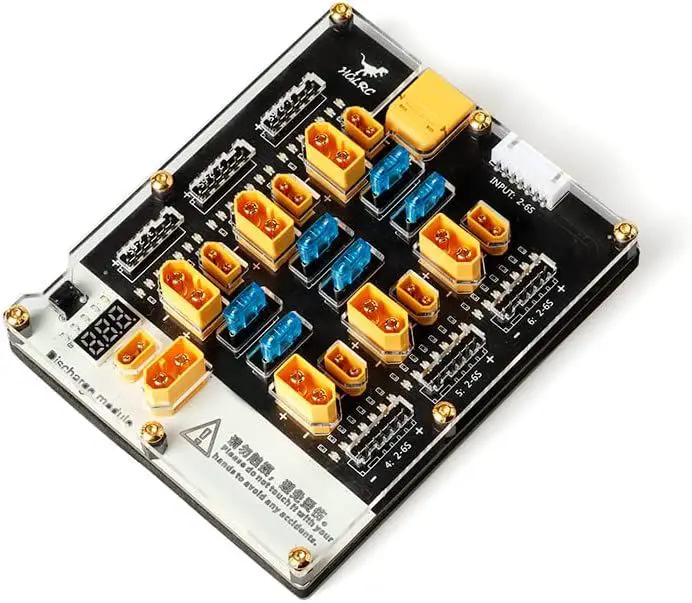A typical FPV LiPo battery pack lasts only for a few minutes, yet requires an hour or more to charge. Charging LiPo batteries is therefore a hassle for many FPV pilots. Fortunately, parallel charging can overcome this hassle.
This guide will teach you all about parallel charging, and my recommended parallel charging boards that you can use.
- What is Parallel Charging?
- Best Parallel Charging Board
- Why is Parallel Charging Dangerous?
- 6 Important Rules to Follow when Doing Parallel Charging
- How to Perform Parallel Charging using a Parallel Charging Board?
- Power Output Requirement for Parallel Charging
- Why should I do Parallel Charging?
- Alternatives to Parallel Charging
What is Parallel Charging?

Parallel charging is a battery charging method where the LiPo batteries are parallelly connected in the circuit through a parallel charging board. This allows multiple LiPo batteries to be charged with just 1 charger.
LiPo batteries connected parallelly form a huge battery with combined capacity, while the voltage remains the same. For instance, 6 pieces of 6S LiPo with 1500 mAh become 9000 mAh in a parallel circuit, while the voltage remains the same at 25.2 V.
In parallel charging, the output current from the charger is shared by all the batteries. Hence, a charger with a higher output current can significantly increase the charging speed during parallel charging.
For instance, to charge 6 pieces of 6S LiPo with 1.5 Ah at 1 C, you need 8 A current output from your charger.
Best Parallel Charging Board
The parallel charging board is a crucial component most FPV pilots would have. This board is where the LiPo batteries will be plugged into. Common parallel charging boards can charge around six to eight batteries simultaneously.
Getting the right parallel charging board is important, because parallel charging can be dangerous, if not properly done.
Here are the best parallel charging boards you should get for your LiPo batteries.
Both Lumenier ParaGuard and HGLRC Thor Pro have a variety of safety features that help reduce the risks associated with parallel charging. That includes replaceable fuse on each battery port, self-resetting fuse on each balance port, and warning LED indicators.
I prefer HGLRC Thor Pro over Lumenier ParaGuard, because the Thor Pro has both XT30 and XT60 ports on the same board, while Lumenier ParaGuard has either XT30 or XT60 ports. If you have both XT30 and XT60 batteries, it makes more sense to buy HGLRC Thor Pro.
Moreover, the Thor Pro has a built-in voltage checker, which is convenient. However, the layout of Thor Pro is slightly more crowded.
The XT60 version of Lumenier ParaGuard supports only 4 LiPo, while the XT30 version supports 6 batteries.
If you are flying only tiny whoops, check out my recommended charging board and multichannel chargers for tiny whoops.
Why is Parallel Charging Dangerous?
Parallel charging is inherently dangerous because all the LiPo batteries are connected together in the same circuit. Any failure or setup mistake can result in disasters. The risks increase as more batteries are charged, but can be mitigated by following best practices and using parallel charging boards with safety features.
6 Important Rules to Follow when Doing Parallel Charging
Connect only LiPo of the same Cell Count
When connected, the higher cell count LiPo (eg. the 6S LiPo) will attempt to charge the one with a lower cell count (eg the 4S LiPo) until both have the same voltage. Since the 4S LiPo’s voltage is capped at 16.8 V while 6S LiPo is 25.2 V, the 4S battery will be overcharged and explode.
Use LiPo with Similar Voltage Balance
When 2 LiPo batteries with significant voltage differences are connected, the higher voltage LiPo will charge the lower voltage LiPo until their voltages are equalized.
Since the discharge rate of the high voltage LiPo is easily 70 C or more, the lower voltage LiPo will be charged at more than 1 C, potentially causing damage to the battery.
Try to keep the voltage differences between the LiPo within 0.1 V per cell.
For instance, if you are charging multiple pieces of 6S LiPo, the voltage difference between those LiPo batteries should not be more than 0.6 V.
Connect the Main Plug in the Correct Polarity
Be wary that connecting the batteries in the wrong polarity can cause shorts and fire. Since the main plugs have a unique shape that prevents you from plugging them in the wrong polarity, this shouldn’t be a big concern.
Connect the Balance Plug Correctly
Depending on the design of the parallel charging board, there could be multiple balance ports or a single multipurpose balance port for LiPo with different cell counts. Make sure you plug in the balance plug to the correct port and correct orientation to prevent shorts and fire.
Use LiPo with Similar Capacity
Most FPV pilots would charge only LiPo of similar capacity simultaneously. There is no real harm in charging multiple LiPo with different capacities, but it’s a good practice to charge only LiPo of similar capacity. Anyway, most likely you will use similar batteries for the same drone.
How to Perform Parallel Charging using a Parallel Charging Board?

To do parallel charging, connect the charging board to a charger. Use only LiPo batteries with the same cell count and similar voltage. Then, connect the LiPo main plug, followed by the balance plug. Calculate the Amp required to set the charging rate, set the voltage according to the cell count, and start charging.
Preparation
Before doing parallel charging, you need to check the voltage of your LiPo. To do this, you need a voltage checker, which is available on some charging boards.
Make sure those LiPo batteries have the same cell count (eg. only 4S or only 6S), and similar voltage. The voltage differences between the LiPo should not be greater than 0.1 V per cell.
If it is not obvious, you can drain the LiPo using your drone to lower its voltage. Or, charge it separately from the rest.
Connect the Main Plug First
As a best practice, always connect the main plug first, before connecting the balance plug. Some pilots prefer to connect the main plugs of all LiPo before proceeding to the balance plugs, while others prefer to connect both plugs before moving on to the second LiPo.
LiPo batteries will try to equalize themselves once they are connected. If the balance plug is connected first, the current will go through the balance lead to equalize the voltage. This is not a big deal if the voltage difference between batteries is small.
However, if the voltage difference between the LiPo is high, connecting the balance plug first may damage the wiring or cause fire, since the balance lead has a low current rating.
Following this best practice will mitigate the risk if you accidentally connect a LiPo with a higher voltage.
Connect the Balance Plug
There are 2 important points to note when connecting the balance plug.
Firstly, make sure you connect the balance plug in the correct orientation. Pay attention to the guidance grooves or markings on the balance ports, so that you connect it correctly.
Secondly, make sure you connect the balance plug to the right ports. For instance, if you are charging a 4S LiPo, use the 4S instead of the 5S balance port. Otherwise, it may cause a short circuit.
Newer boards use all-in-one balance ports. In such a case, make sure the negative pin is always connected to the negative port.
Calculate the Charging Rate
When charging LiPo batteries parallelly, the output current from the charger will be divided equally to all LiPo. Hence, it is important to consider the capacity of all batteries when setting up the charging rate.
To charge at 1 C in parallel charging, add up the capacity of all LiPo batteries. The sum of the capacity is the current output required for 1 C charging rate.
For instance, if you want to charge 6 LiPo, each with 1000 mAh at 1 C, the required current output is 6000 mA.
Setting the Voltage
While the charging rate calculation in parallel charging is different from single battery charging, the voltage setting remains the same. You do not need to add up the voltage of all batteries.
Remember, the maximum voltage for LiPo is 4.2 V per cell. So, a 4S LiPo is 16.8 V, and a 6S is 25.2 V. If you are charging 6S LiPo, set the voltage to 25.2 V, regardless of the number of LiPo batteries you are charging.
Power Output Requirement for Parallel Charging
To enjoy the full benefit of parallel charging, you need a charger with a high current output and power rating. Don’t forget to check out my recommended chargers.
As explained earlier, to charge at 1 C, you need to add up the capacity of all LiPo involved. If you plan to regularly charge 6 pieces of 6S LiPo with 1500 mAh, a charger with at least 9 A output is required (6 times 1.5 A). You can definitely charge at a rate lower than 1 C, but it will take longer for the LiPo to be fully charged.
In the same scenario, you need the charger to be rated with at least 226.8 W output (the product of 25.2 V and 9 A) to provide 9 A current. If your charger is rated 200 W, you can only charge at 7.9 A (200 W divided by 25.2 V), which is effectively 0.88 C, even though your charger output is rated at 10 A.
Why should I do Parallel Charging?
Parallel charging is the faster way to charge multiple LiPo batteries at once. Even if you have a lower output charger, and can only charge at lower C ratings, you don’t need to repeatedly unplug the charged battery and plug in another one until all batteries are fully charged.
If you have a high output charger, you can connect multiple charging boards in a daisy chain to charge 20, 30, or even more batteries simultaneously.
Alternatives to Parallel Charging
A safer alternative to charging multiple LiPo is by using a multichannel charger. It charges multiple LiPo packs at the same time, without having to connect them through a parallel charging board. It’s believed to be safer because the LiPo packs are not connected.
At the same time, multichannel chargers allow you to charge batteries with different specifications, unlike parallel charging where you need to have the similar voltage and same cell count for each LiPo pack.
However, multichannel chargers are expensive. Affordable multichannel chargers can charge only 2-4 LiPo simultaneously.
Here is the comparison table between parallel charging versus multichannel charging.
| Features | Parallel Charging | Multichannel Charging |
|---|---|---|
| Charger price | Cheap | Expensive |
| Parallel charging board | Required | Not required |
| Battery requirements | Batteries of same cell count and voltage | No constraints |
| Maximum supported LiPo | Commonly 4-6, theoretically unlimited if daisy-chained | Commonly 2-4 |
| Safety | Prone to manual error | Less prone to manual error |
Another alternative is to buy multiple chargers so that you can charge multiple LiPo at the same time.






